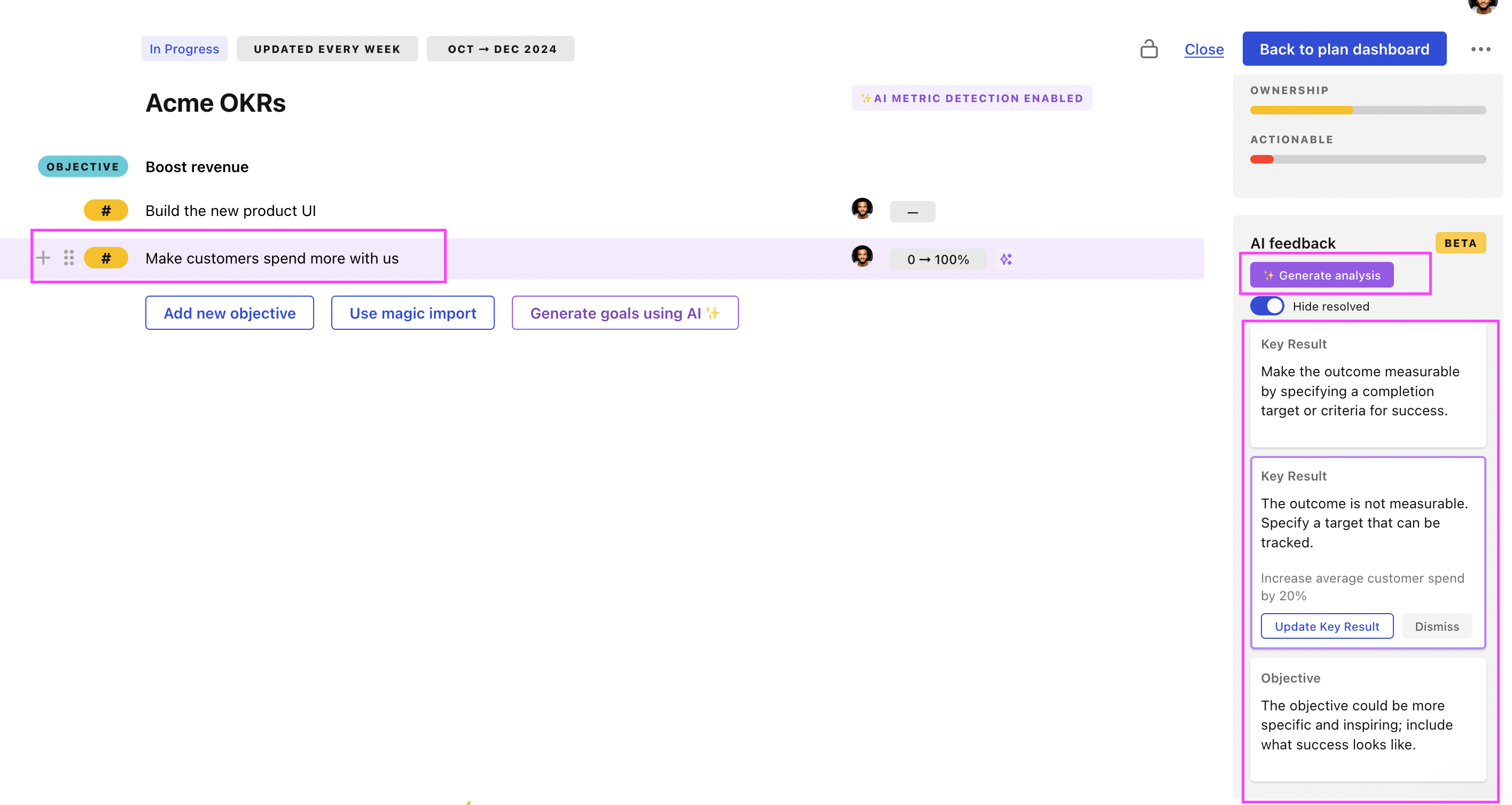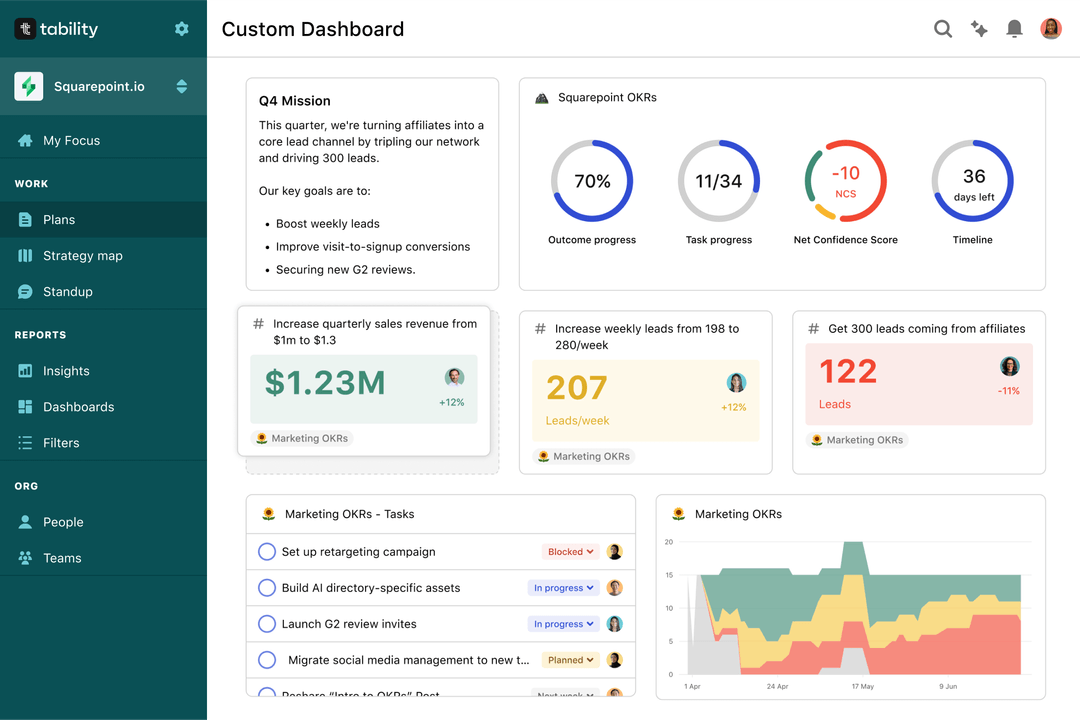Tability is a cheatcode for goal-driven teams. Set perfect OKRs with AI, stay focused on the work that matters.
What are Remote Employee OKRs?
The OKR acronym stands for Objectives and Key Results. It's a goal-setting framework that was introduced at Intel by Andy Grove in the 70s, and it became popular after John Doerr introduced it to Google in the 90s. OKRs helps teams has a shared language to set ambitious goals and track progress towards them.
Formulating strong OKRs can be a complex endeavor, particularly for first-timers. Prioritizing outcomes over projects is crucial when developing your plans.
We've tailored a list of OKRs examples for Remote Employee to help you. You can look at any of the templates below to get some inspiration for your own goals.
If you want to learn more about the framework, you can read our OKR guide online.
The best tools for writing perfect Remote Employee OKRs
Here are 2 tools that can help you draft your OKRs in no time.
Tability AI: to generate OKRs based on a prompt
Tability AI allows you to describe your goals in a prompt, and generate a fully editable OKR template in seconds.
- 1. Create a Tability account
- 2. Click on the Generate goals using AI
- 3. Describe your goals in a prompt
- 4. Get your fully editable OKR template
- 5. Publish to start tracking progress and get automated OKR dashboards
Watch the video below to see it in action 👇
Tability Feedback: to improve existing OKRs
You can use Tability's AI feedback to improve your OKRs if you already have existing goals.
- 1. Create your Tability account
- 2. Add your existing OKRs (you can import them from a spreadsheet)
- 3. Click on Generate analysis
- 4. Review the suggestions and decide to accept or dismiss them
- 5. Publish to start tracking progress and get automated OKR dashboards

Tability will scan your OKRs and offer different suggestions to improve them. This can range from a small rewrite of a statement to make it clearer to a complete rewrite of the entire OKR.
Remote Employee OKRs examples
You'll find below a list of Objectives and Key Results templates for Remote Employee. We also included strategic projects for each template to make it easier to understand the difference between key results and projects.
Hope you'll find this helpful!
OKRs to strengthen team communication for remote workers utilizing Slack
ObjectiveStrengthen team communication for remote workers utilizing Slack
KREnhance clarity of messages through a 15% decrease in miscommunication
Develop a standardized communication framework with clear guidelines for effective messaging
Conduct regular trainings and workshops on active listening and verbal/non-verbal communication
Implement a feedback system to address and resolve any miscommunication promptly
Encourage the use of visual aids or diagrams to supplement written or spoken communication
KRIncrease the utilization of Slack's collaboration features by 30%
Create and distribute a comprehensive guide highlighting Slack's collaboration features
Encourage team leaders to incorporate Slack's collaboration tools into their daily workflows
Regularly share success stories and best practices of utilizing Slack's collaboration tools
Host training sessions to teach employees how to effectively utilize Slack's collaboration features
KRImprove participation in team channels by at least 25%
Provide ongoing training and resources on effective communication to support increased participation
Implement a daily reminder to encourage team members to actively participate in channels
Share success stories of active participants to inspire and motivate others to join in
Organize regular team challenges to promote engagement and increase participation in channels
KRIncrease average response time on Slack by 20%
Provide regular training and guidance on effective and efficient communication practices
Analyze response time data to identify bottlenecks and areas for improvement
Implement productivity tools and shortcuts to streamline communication and reduce response time
Encourage team members to adopt time management techniques to prioritize and respond promptly
OKRs to enhance positivity and professionalism in a remote working environment
ObjectiveEnhance positivity and professionalism in a remote working environment
KRAchieve zero instances of missed deadlines or meetings within a given month
Set reminders for all deadlines and meetings
Implement a daily schedule and strictly adhere to it
Prioritize tasks based on deadline proximity
KRReceive 90% positive feedback in post-meeting surveys on professionalism and engagement
Solicit and actively address attendee concerns and suggestions
Enhance communication skills through professional development courses
Develop and implement pre-meeting preparation strategies
KRAttend a minimum of two skill development webinars on positive communication per month
Register for two chosen webinars
Attend and participate in the webinars
Research suitable positive communication webinars
OKRs to enhance environmental responsibility in our daily operations
ObjectiveEnhance environmental responsibility in our daily operations
KRReduce company-wide paper consumption by 15%
Promote a company-wide paper recycling program
Implement double-sided printing as the default setting
Transition to digital documents for meetings
KRLower carbon emissions from transportation by achieving a 25% remote work rate
Provide technology supports for employees working remotely
Implement a flexible remote work policy for 25% of the workforce
Communicate the benefits and expectations of remote work
KRIncrease employee participation in recycling programs by 20%
Regularly update and simplify recycling bins labeling
Introduce attractive incentives for active recycling participants
Implement mandatory environmental awareness and recycling training sessions
Remote Employee OKR best practices
Generally speaking, your objectives should be ambitious yet achievable, and your key results should be measurable and time-bound (using the SMART framework can be helpful). It is also recommended to list strategic initiatives under your key results, as it'll help you avoid the common mistake of listing projects in your KRs.
Here are a couple of best practices extracted from our OKR implementation guide 👇
Tip #1: Limit the number of key results
The #1 role of OKRs is to help you and your team focus on what really matters. Business-as-usual activities will still be happening, but you do not need to track your entire roadmap in the OKRs.
We recommend having 3-4 objectives, and 3-4 key results per objective. A platform like Tability can run audits on your data to help you identify the plans that have too many goals.
Tip #2: Commit to weekly OKR check-ins
Don't fall into the set-and-forget trap. It is important to adopt a weekly check-in process to get the full value of your OKRs and make your strategy agile – otherwise this is nothing more than a reporting exercise.
Being able to see trends for your key results will also keep yourself honest.
Tip #3: No more than 2 yellow statuses in a row
Yes, this is another tip for goal-tracking instead of goal-setting (but you'll get plenty of OKR examples above). But, once you have your goals defined, it will be your ability to keep the right sense of urgency that will make the difference.
As a rule of thumb, it's best to avoid having more than 2 yellow/at risk statuses in a row.
Make a call on the 3rd update. You should be either back on track, or off track. This sounds harsh but it's the best way to signal risks early enough to fix things.
Save hours with automated Remote Employee OKR dashboards

Your quarterly OKRs should be tracked weekly if you want to get all the benefits of the OKRs framework. Reviewing progress periodically has several advantages:
- It brings the goals back to the top of the mind
- It will highlight poorly set OKRs
- It will surface execution risks
- It improves transparency and accountability
We recommend using a spreadsheet for your first OKRs cycle. You'll need to get familiar with the scoring and tracking first. Then, you can scale your OKRs process by using Tability to save time with automated OKR dashboards, data connectors, and actionable insights.
How to get Tability dashboards:
- 1. Create a Tability account
- 2. Use the importers to add your OKRs (works with any spreadsheet or doc)
- 3. Publish your OKR plan
That's it! Tability will instantly get access to 10+ dashboards to monitor progress, visualise trends, and identify risks early.
More Remote Employee OKR templates
We have more templates to help you draft your team goals and OKRs.
OKRs to obtain position as Director of Product
OKRs to elevate WorldFirst brand globally on social platforms
OKRs to instill value-driven mindset across all work processes
OKRs to enhance satisfaction of wealth management clients
OKRs to enhance the quality of prospective business leads
OKRs to enhance proficiency in answering sales pitches